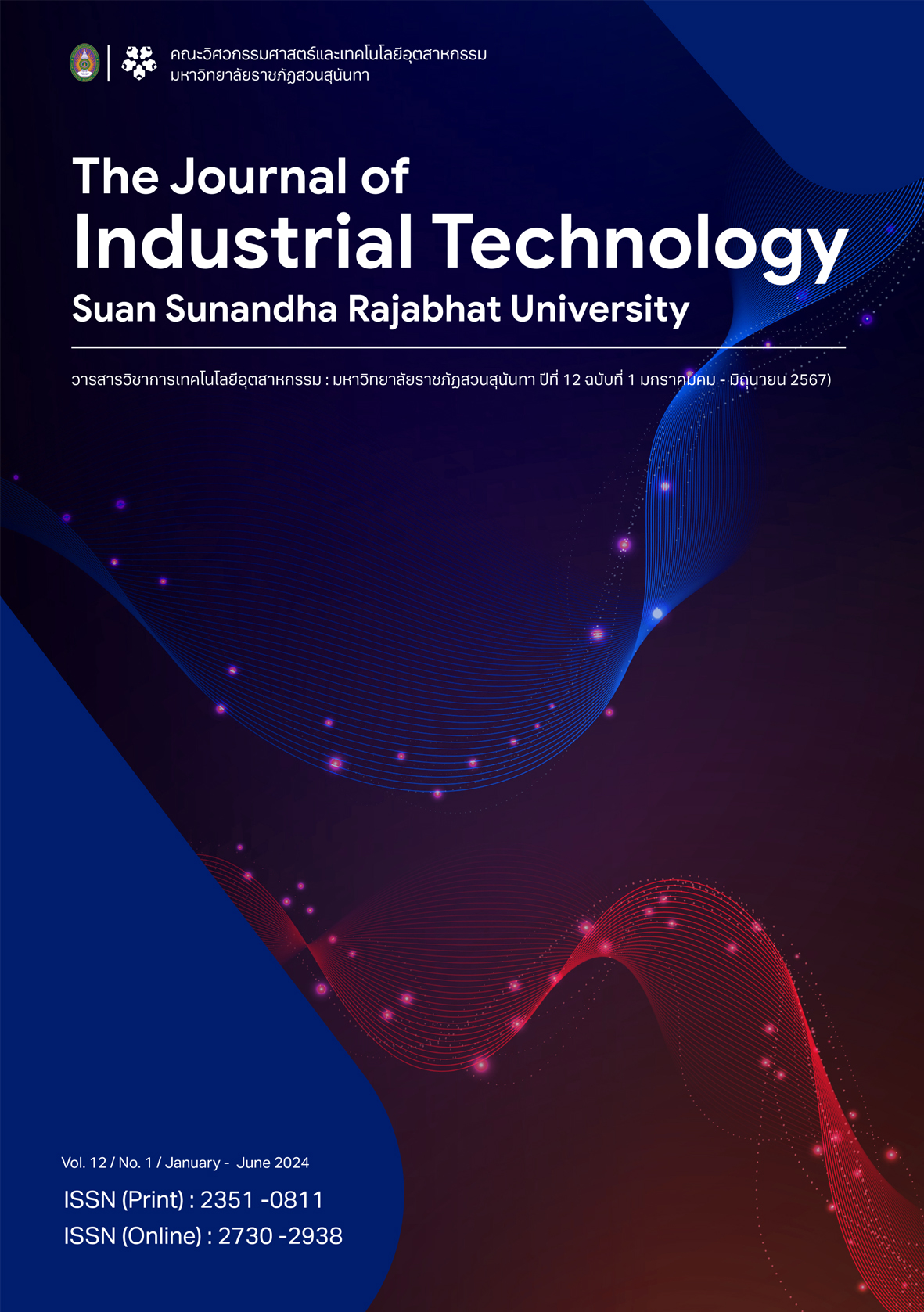การประยุกต์ใช้แบบจำลองสารสนเทศอาคารที่ระดับการพัฒนาต่างกันเพื่อเพิ่มความแม่นยำในการคำนวณปริมาณวัสดุสำหรับผนังก่ออิฐฉาบปูน
คำสำคัญ:
แบบจำลองสารสนเทศอาคาร (BIM), การถอดปริมาณวัสดุ, สมการถดถอยเชิงเส้นบทคัดย่อ
การวิจัยนี้มีวัตถุประสงค์เพื่อสร้างและเปรียบเทียบแบบจำลองสารสนเทศอาคาร (BIM) ที่ระดับการพัฒนา (Level of Development: LOD) LOD300 และ LOD400 ของอาคารพักอาศัยกึ่งสำนักงาน 7 ชั้น โดยใช้โปรแกรม Autodesk Revit และถอดปริมาณวัสดุของผนังก่ออิฐฉาบปูน เพื่อเปรียบเทียบกับปริมาณวัสดุที่ถอดจากแบบก่อสร้าง 2 มิติ ที่ผู้รับเหมาได้คำนวณไว้ ผลการวิจัยพบว่า ค่าความคลาดเคลื่อนของปริมาณวัสดุจาก BOQ (Bill of Quantities) กับแบบจำลอง LOD300 ของปริมาณงานก่อผนังหนา 100 มม. เท่ากับ 3.98% ปริมาณงานก่อผนังหนา 200 มม. เท่ากับ 11.24% ปริมาณงานฉาบผนัง เท่ากับ 38.85% และที่ระดับ LOD400 ของปริมาณงานก่อผนังหนา 100 มม. เท่ากับ 10.54% ปริมาณงานก่อผนังหนา 200 มม. เท่ากับ 19.18% ปริมาณงานฉาบผนัง เท่ากับ 38.85% และปริมาณงานเสาเอ็น-คานทับหลัง เท่ากับ 0.95% นอกจากนี้ยังพบว่าสมการถดถอยเชิงเส้นที่สร้างขึ้นสามารถทำนายปริมาณวัสดุได้อย่างแม่นยำ โดยมี R2 อยู่ระหว่าง 0.9942 ถึง 1 ซึ่งจะช่วยลดความคลาดเคลื่อนในการคำนวณปริมาณวัสดุได้อย่างมีนัยสำคัญ
References
United Nations Environment Programme, “Global Status Report for Buildings and Construction,” May. 28, 2024. [Online]. Available: https://www.unep.org/resources/report/global-status-report-buildings-and-construction
C. Luangcharoenrat, S. Intrachooto, V. Peansupap and W. Sutthinarakorn, “Factors influencing construction waste generation in building construction: Thailand’s perspective,” Sustainability, vol. 11, no. 13, p. 3638, Jul. 2019.
W. Lertpaitoopan and S. Santiyanon, “Factors influencing construction waste generation in building construction project: A path analysis approach,” Proceedings of NIVCMR (The 5th National and International Virtual Conference on Multidisciplinary Research), Buriram, April. 25, 2022, pp. 404–414.
K. N. Ali, H. H. Alhajlah and M. A. Kassem, “Collaboration and risk in building information modelling (BIM): A systematic literature review,” Buildings, vol. 12, no. 5, pp. 571, Apr. 2022.
Z. Liu, Y. Lu, and L.C. Peh, “A review and scientometric analysis of global Building Information Modeling (BIM) research in the architecture, engineering and construction (AEC) industry,” Buildings, vol. 9, no. 10, pp. 210, Sep. 2019.
C. Khosakitchalert, N. Yabuki, and T. Fukuda, “Improving the accuracy of BIM-based quantity takeoff for compound elements,” Automation in Construction, vol. 106, pp. 102891, Oct.2019. doi:10.1016/j.autcon.2019.102891
P. Pawan and P. Mekarkart, “Application of regression model to develop quantity take-off processes for reinforce concrete building using BIM Software,” Proceedings of the 7th RMUTP Conference on Engineering and Technology, Bangkok, 19 May. 2023, pp. 337–342.
M. N. Uddin, H. H. Wei, H. L. Chi, M. Ni, and P. Elumalai, “Building Information Modeling (BIM) incorporated green building analysis: An application of local construction materials and sustainable practice in the built environment,” Journal of Building Pathology and Rehabilitation, vol. 6, no. 1, Mar. 2021.
L. P. Khant, D. D. Widjaja, K. Kwon, and S. Kim, “A BIM-based bar bending schedule generation algorithm with enhanced accuracy,” Buildings, vol. 14, no. 5, pp. 1207, Apr. 2024.
P. Pawan and W. Lertpaitoonpan, “Minimizing gable roofing materials in proactive design phase by using a genetic algorithm to estimate the purlin spacings,” Proceedings of the 28th National Convention on Civil Engineering, Phuket, pp. BIM02-1–BIM02-6, May. 2023.
The association of Siamese architects under royal patronage, “institute of Siamese architects,” Bangkok: Plus Press, 2015.
Committee to establish standards for the use of building information modeling, “According to the professional council guidelines for the year 2020-2022,” Bangkok: The engineering institute of Thailand under H.M. the King’s patronage, 2020.
M. Y. Mahendra, N. Kartika, and Tahadjuddin. “Calculation of cost estimation based on building information modeling in construction projects,” International Journal of Natural Science and Engineering, vol. 7, no.1, pp. 71–83, Apr. 2023.
Z. Xu, X. Gao, Z. Song, X. Tian and X. Jiang, “Research on the application of BIM technology in construction cost management," 2022 International Conference on Wireless Communications, Electrical Engineering and Automation (WCEEA), Indianapolis, IN, USA, 2022, pp. 214–217.
A. Wahab and J. Wang, “Factors-driven comparison between BIM-based and traditional 2D quantity takeoff in construction cost estimation,” Engineering, Construction and Architectural Management, Vol. 29 No. 2, pp. 702–715, Mar. 2022.
S. E. Purba, N. Diandra, and C.W. Feng, “Employing the bim-based approach to analyze and improve the quality of detail construction cost estimation according to NRM 2 and SMPI,” Jurnal Teknik Sipil, vol. 22, no. 2, pp.75–83, Dec. 2022.
Downloads
เผยแพร่แล้ว
How to Cite
ฉบับ
บท
License
Copyright (c) 2024 คณะวิศวกรรมศาสตร์และเทคโนโลยีอุตสาหกรรม มหาวิทยาลัยราชภัฎสวนสุนันทา

This work is licensed under a Creative Commons Attribution-NonCommercial-NoDerivatives 4.0 International License.
บทความที่ได้รับการตีพิมพ์เป็นลิขสิทธิ์ของคณะวิศวกรรมศาสตร์และเทคโนโลยีอุตสาหกรรม มหาวิทยาลัยราชภัฎสวนสุนันทา
ข้อความที่ปรากฏในบทความแต่ละเรื่องในวารสารวิชาการเล่มนี้เป็นความคิดเห็นส่วนตัวของผู้เขียนแต่ละท่านไม่เกี่ยวข้องกับมหาวิทยาลัยราชภัฎสวนสุนันทา และคณาจารย์ท่านอื่นๆในมหาวิทยาลัยฯ แต่อย่างใด ความรับผิดชอบองค์ประกอบทั้งหมดของบทความแต่ละเรื่องเป็นของผู้เขียนแต่ละท่าน หากมีความผิดพลาดใดๆ ผู้เขียนแต่ละท่านจะรับผิดชอบบทความของตนเองแต่ผู้เดียว







